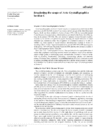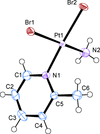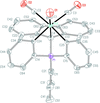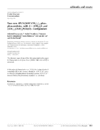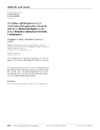issue contents
April 2013 issue

Cover illustration: The heavy-atom framework in MgSO4·11H2O (with H atoms omitted for clarity). Dashed and solid lines are used to distinguish the hydrogen-bonded rings in different planes. See Fortes, Wood & Gutmann [Acta Cryst. (2013), C69, 324-329].
editorial
Free 

inorganic compounds
Download citation


Download citation


A sample of Li0.41(NH4)0.59ClO4 was prepared by gel diffusion using agar agar gel as the medium of growth at ambient temperature. The Cl and mixed Li/N atoms are located on special positions. The structure features a twofold interpenetrated three-dimensional entanglement architecture, in which single three-dimensional networks are constructed from tetrahedral coordination based on diamondoid arrays. The crystal structure is compared with those of related compounds.
Download citation


Download citation


Four clathrates with type-I and type-II structure are reported in the K–Ba–Ga–Sn system. For the type-I compound, all framework sites are occupied by a mixture of Ga and Sn atoms, with Ga showing a preference for Wyckoff site 6c. For the type-II structures, only the smaller (Ga,Sn)24 pentagonal dodecahedral cages are filled, while the (Ga,Sn)28 hexakaidecahedral cages remain empty.
Download citation


Download citation


The structure of magnesium sulfate undecahydrate and its hexavalent chromium-bearing analogue are compared, elucidating details of the strain distribution through the hydrogen-bonded structure due to the substitution of a much larger oxyanion.
Download citation


Download citation


Analysis of the title compound, diiron(III) trisulfate–sulfuric acid–water (1/1/28), at 100 and 200 K reveals the structural features of an alum, (H5O2)Fe(SO4)2·12H2O. The Fe(H2O)6 unit is located on a centre of inversion, while the H5O2+ cation is located about an inversion centre. The compound thus represents the first oxonium alum, although the unit cell is orthorhombic.
Download citation


Download citation


The crystal structure of KAlSiO4-O1 was refined from single-crystal data, taking multiple twinning into account. Electron microprobe analysis confirmed that the compound is not stoichiometric.
metal-organic compounds
Download citation


Download citation


Download citation


Download citation


Download citation


Download citation


Download citation


Download citation


Download citation


Download citation


Download citation


Download citation


Download citation


Download citation


Download citation


Download citation


Download citation


Download citation


Download citation


Download citation


Download citation


Download citation


Download citation


Download citation


Download citation


Download citation


Download citation


Download citation


Download citation


Download citation


organic compounds
Download citation


Download citation


Download citation


Download citation


Download citation


Download citation


Download citation


Download citation


Download citation


Download citation


Download citation


Download citation


Download citation


Download citation


Download citation


Download citation


Download citation


Download citation


Download citation


Download citation


Download citation


Download citation


addenda and errata
Free 

Free 



 journal menu
journal menu








